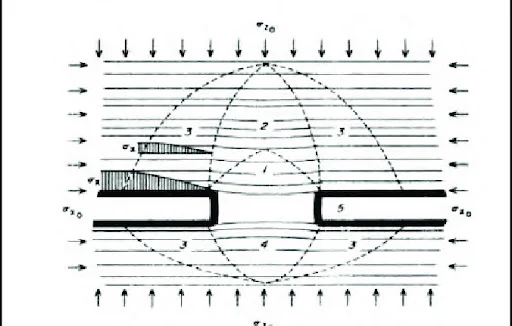Stress distribution around mines Openings
Stress distribution around mines Openings:
The distribution of stress around mine openings depends on several factors, including the geological conditions, the type of mine opening, and the mining method used. Here are some general concepts related to stress distribution around mine openings:
1. Stress Concentration: Mine openings, such as tunnels, shafts, or adits, create disruptions in the surrounding rock mass. These disruptions can lead to stress concentration at the edges of the openings. The stress concentration is typically highest near the corners and decreases with distance from the opening.
2. Stress Redistribution: When a mine opening is excavated, the stress in the surrounding rock mass redistributes to achieve a new equilibrium. Initially, the stress redistribution occurs rapidly, resulting in high stresses around the opening. Over time, the stresses gradually adjust and reach a more stable state.
3. Stress Gradients: The stress distribution around mine openings is characterized by stress gradients. The stress is highest near the opening and decreases with distance from the opening. The rate of stress decrease depends on factors such as the rock mass properties, the size of the opening, and the depth of the mine.
4. Stress Anisotropy: Rock mass behavior is often anisotropic, meaning that it exhibits different mechanical properties in different directions. Anisotropy can influence the stress distribution around mine openings, causing variations in stress magnitude and orientation.
5. Stress Induced Displacements: High stresses around mine openings can induce rock mass displacements. These displacements can lead to ground deformations, such as convergence or closure of the opening, which can affect the stability and support requirements of the mine.
It's important to note that the specific stress distribution around mine openings can vary significantly based on the geological and mining conditions. Engineers and geologists employ various techniques, including numerical modeling and field observations, to understand and predict the stress distribution accurately.





Post a Comment